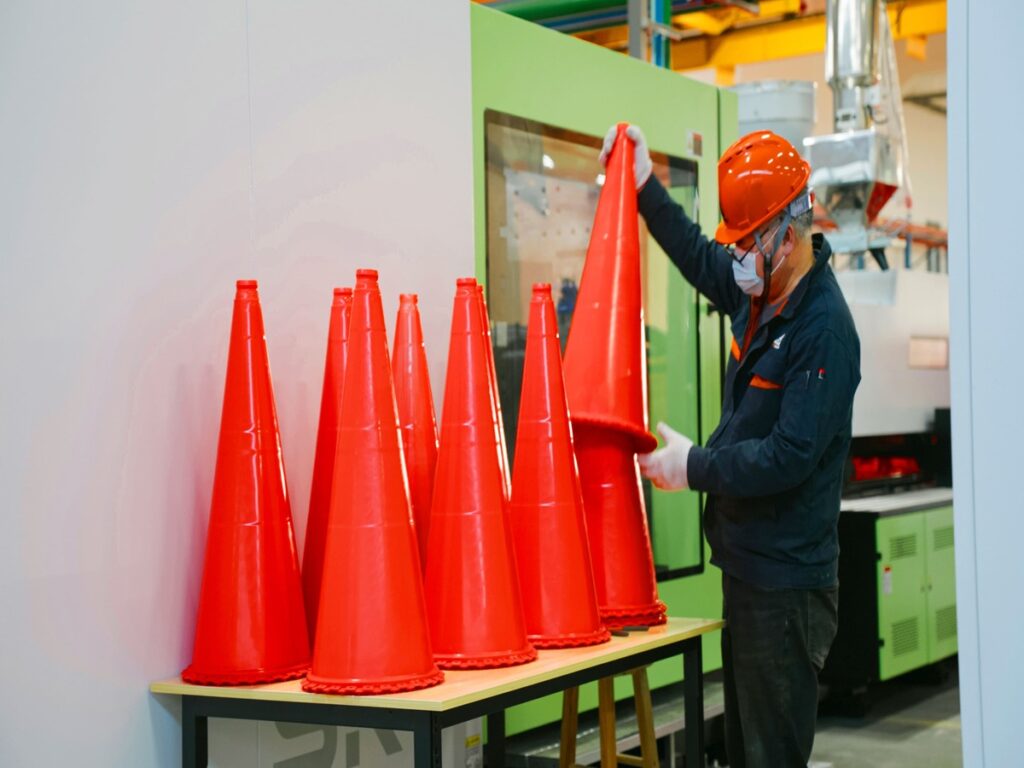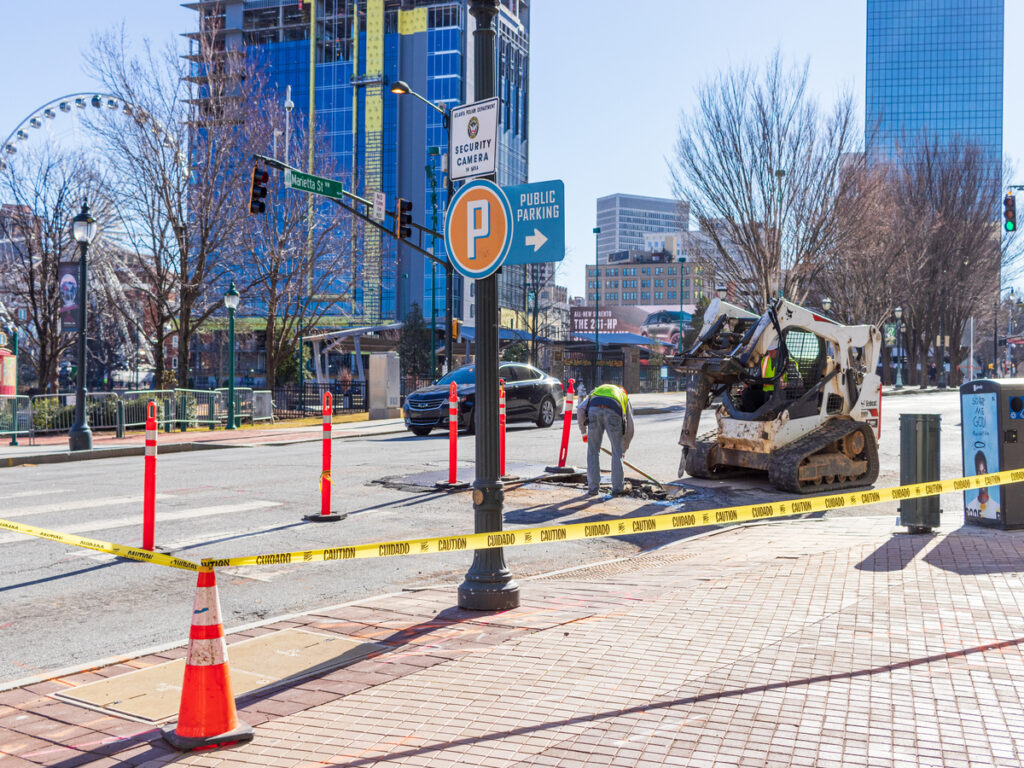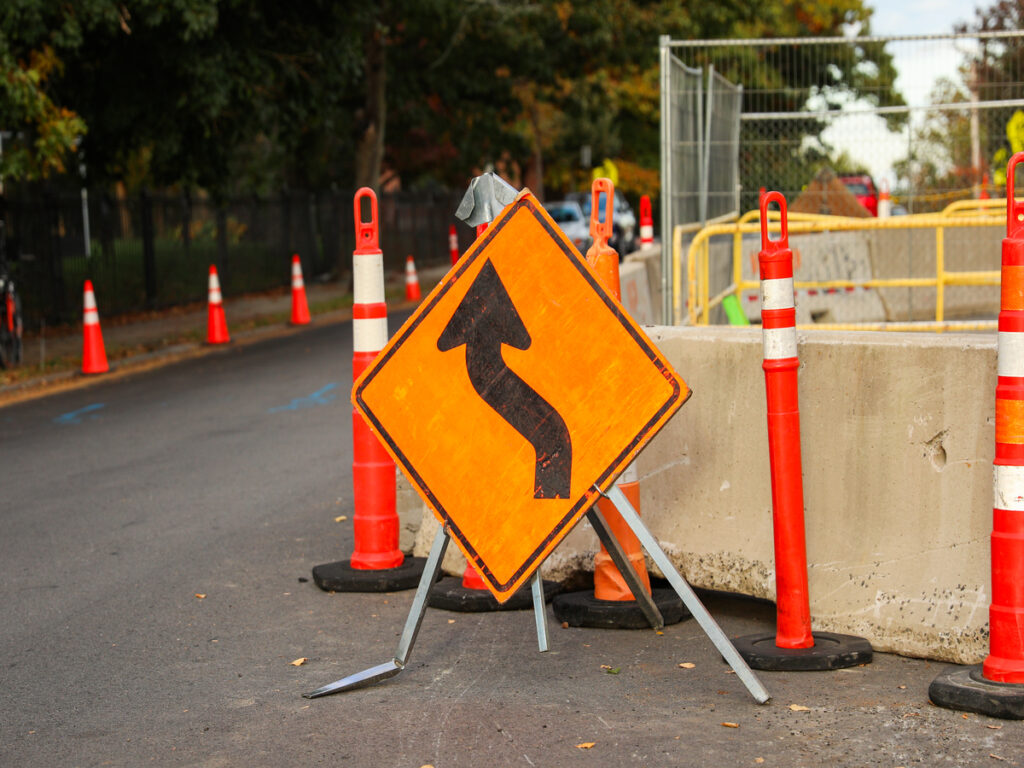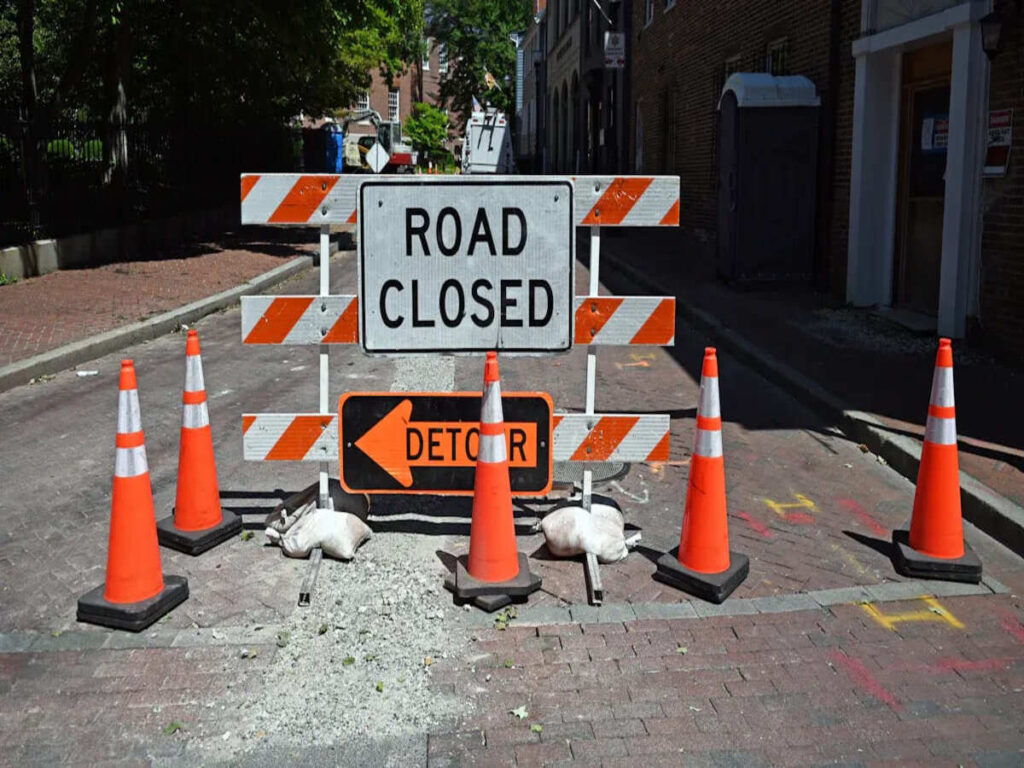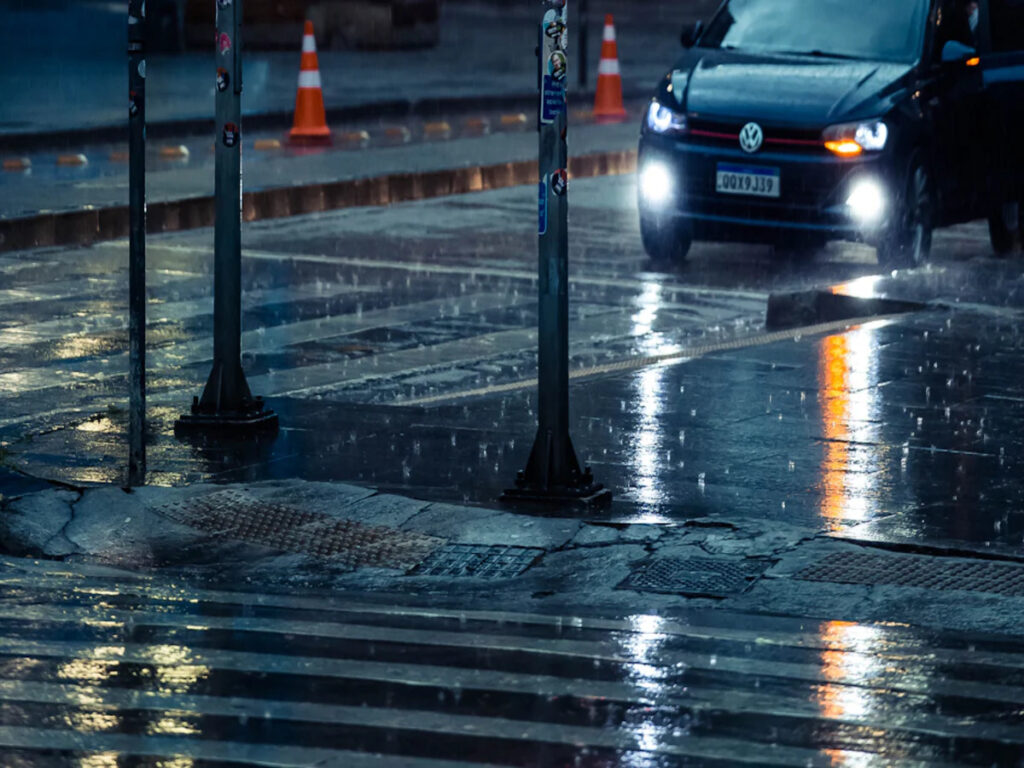
Torrential rain creates dangerous conditions on roads. Heavy downpours reduce visibility, making it harder for drivers to see obstacles or other vehicles. Wet surfaces increase the risk of skidding, while pooling water can lead to hydroplaning. These hazards often result in accidents, especially when drivers cannot identify problem areas quickly.
Traffic cones play a vital role in improving road safety during such weather. Their reflective tape and bright colors make them highly visible, even in low light. They alert you to hazards like icy patches or waterlogged sections. Traffic cones with reflective tape also guide vehicles around obstacles, helping you avoid accidents and navigate safely through changing road conditions. OPTsigns traffic cones are designed with durability and visibility in mind, making them the perfect choice for ensuring safety on the road during adverse weather conditions.
The Challenges of Heavy Rain on Road Safety
Hazards Caused by Heavy Rain
Driving during heavy rain presents unique challenges that can compromise your safety. Rainfall reduces visibility, making it harder to see other vehicles, pedestrians, or road signs. Statistics show that rain contributes to 11% of crashes, 10% of injuries, and 8% of fatalities annually. These numbers highlight the dangers of driving in wet conditions.
Several factors make heavy rain particularly hazardous:
- Rain decreases visibility significantly, especially during nighttime or early morning hours.
- Slick roads delay reaction times, increasing the likelihood of collisions.
- Hydroplaning occurs when your tires lose traction on wet surfaces, causing a loss of control.
- Standing water can conceal potholes or other road hazards, making them difficult to detect.
In addition to these risks, inclement weather like fog often accompanies rain, further reducing visibility. Over 38,700 vehicle crashes occur annually in foggy conditions, resulting in more than 16,300 injuries and over 600 fatalities. These statistics emphasize the importance of staying alert and cautious when driving in adverse weather.
The Importance of Safety Equipment in Stormy Weather
Safety equipment plays a critical role in protecting you during inclement weather. Traffic cones, reflective signs, and hazard lights are essential tools for managing road safety in stormy conditions. These items help you identify dangerous areas and navigate safely through challenging environments.
Traffic cones, in particular, stand out as a reliable safety measure. Their bright colors and reflective materials make them visible even in low-light or rainy conditions. They guide you around flooded areas, warn you of slippery roads, and mark accident sites. Without such equipment, navigating through heavy rain becomes significantly riskier.
When driving in inclement weather, always pay attention to safety markers. They are strategically placed to minimize risks and ensure your safety. Proper use of safety equipment can make a significant difference in preventing accidents and saving lives.
The Role of Traffic Cones in Enhancing Road Visibility
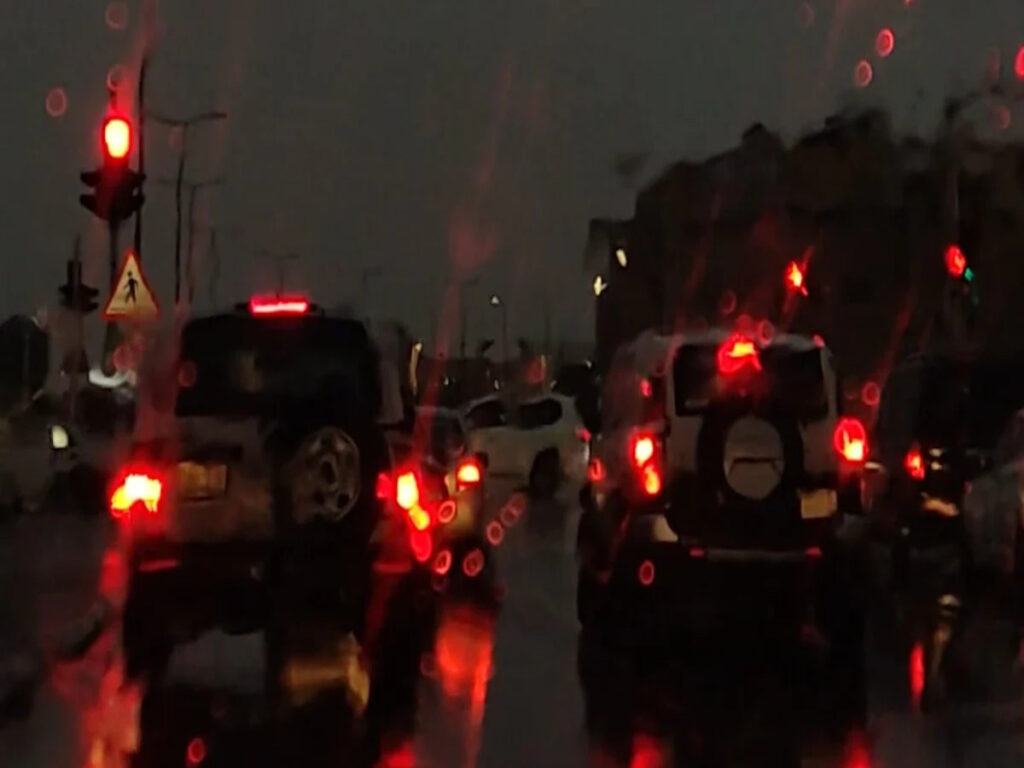
Reflective Materials for Low Visibility
Traffic cones are designed to stand out, even in the darkest conditions. Reflective strips or coatings on these cones significantly improve their visibility during nighttime or heavy rain. These strips use retroreflective materials, such as microscopic glass beads or microprisms, to reflect light from vehicle headlights directly back to you. This creates a bright, clear visual cue that helps you identify hazards quickly.
The materials used in traffic cones, such as durable plastic and rubber, ensure they remain effective in all weather conditions. Rain, fog, or dim lighting won’t diminish their performance. Reflective strips also bounce light from streetlights or other vehicles, making the cones easier to spot. This enhanced visibility is crucial for guiding drivers safely through stormy weather.
High-Visibility Colors
The bright colors of traffic cones, such as orange and neon yellow, play a key role in improving visibility. These high-visibility colors are easy to spot, even in poor lighting or heavy rain. They help you react faster to hazards, reducing the risk of accidents.
Reflective materials, like 3M 3340 prismatic coatings, further enhance the effectiveness of these colors. This combination ensures that traffic cones remain visible in all conditions, keeping you and other road users safe. High-visibility colors are especially important during storms, when reduced lighting makes it harder to see road signs or obstacles.
Cones vs. Other Road Safety Tools
Traffic cones offer several advantages over other road safety tools during heavy rain. Their bright colors and reflective strips make them highly visible, even in low-light conditions. Unlike some equipment, reflective cones are durable and can withstand harsh weather without losing effectiveness.
Their portability allows for quick deployment, which is essential during emergencies. You can set them up rapidly to mark flooded areas, slippery roads, or accident sites. Other tools, like barricades or signs, may take longer to install and lack the same level of visibility. Traffic cones provide a reliable, efficient solution for managing road hazards in stormy weather.
OPTsigns traffic cones are designed to meet the highest standards for visibility, durability, and ease of use, making them an ideal choice for ensuring road safety during adverse weather conditions.
How Traffic Cones Help Manage Road Hazards in Flooded Areas

Marking Flooded or Waterlogged Roads
Flooded roads pose a serious risk to drivers. Water can hide potholes, debris, or uneven surfaces, making it difficult for you to judge the road’s condition. Traffic cones act as a clear warning system in these situations. Their bright colors and reflective materials make them easy to spot, even in heavy rain or low light.
Proper placement of traffic cones is essential for keeping you safe. Cones are often arranged in a line to block off flooded sections or guide you toward safer paths. Taller reflective cones are used in high-speed areas, ensuring you can see them from a distance. This early warning gives you enough time to slow down and adjust your route.
When you encounter traffic cones marking a waterlogged area, always proceed with caution. These reflective cones are there to protect you from hidden dangers beneath the water.
Hydroplaning Prevention
Hydroplaning happens when your tires lose contact with the road due to a layer of water. This can cause you to lose control of your vehicle, increasing the risk of accidents. Traffic cones help reduce this danger by directing you away from areas where water has accumulated.
Cones placed strategically around large puddles or waterlogged sections guide you to safer lanes. By following these markers, you can avoid driving through deep water, which reduces the chances of hydroplaning. The reflective strips on the cones ensure you can see them clearly, even in poor visibility.
Pay attention to traffic cones during storms. They are not just markers; they are tools designed to keep you safe and help you navigate hazardous conditions effectively.
Best Practices for Using Traffic Cones in Stormy Conditions

Proper Cone Placement
Placing traffic cones correctly is essential for effective traffic management during stormy weather. You should position cones in a way that clearly marks hazards, such as flooded areas or slippery roads. Arrange them in straight lines or patterns that guide drivers safely around obstacles. For example, use cones to create a detour around waterlogged sections or accident sites.
Spacing between reflective cones matters too. On highways or high-speed roads, place cones farther apart to give drivers more time to react. In urban areas or low-speed zones, keep the cones closer together for better visibility. Always ensure the reflective road cones are visible from a distance, even in heavy rain. Proper placement helps you and other road users navigate safely through hazardous conditions.
Securing Cones in Adverse Weather
Stormy conditions often bring strong winds, which can displace traffic cones. To prevent this, use weighted bases or sandbags to secure the reflective safety cones. This ensures they stay in place, even during heavy rain or gusty winds. You can also use taller reflective safety cones, which are less likely to tip over.
When securing cones, check that they remain upright and visible. A fallen cone can confuse drivers and create additional hazards. Regularly inspect the cones during storms to ensure they are still in their intended positions. Securing traffic cones properly enhances their effectiveness as traffic safety equipment and keeps the road safer for everyone.
Combining Cones with Other Safety Measures
Using traffic cones alongside other safety equipment improves visibility and reduces risks during storms. Combine cones with retro-reflective tape or LED lights to make them visible from a greater distance. This is especially useful in low-light conditions.
Other safety equipment, such as warning signs or flashing lights, complements traffic cones by marking hazards like icy patches or snow-covered obstacles. Together, these tools guide traffic flow around dangers, creating safe detours and preventing vehicles from veering off the road. By combining reflective safety cones with additional safety measures, you enhance traffic safety equipment and ensure better protection for all road users.
The Benefits of High-Quality Reflective Traffic Cones in Wet Conditions
Durability in Harsh Weather
High-quality reflective traffic cones are built to endure extreme weather. These reflective cones use materials like reinforced plastic, PVC, and rubber, which resist cracking or breaking under pressure. Heavy-duty cones remain stable even in freezing temperatures, ensuring they perform well in icy or snowy conditions. Some cones, such as the Enviro-Cone made from Low-Density Polyethylene (LDPE), stay flexible and durable even in severe cold.
The design of these reflective safety cones also enhances their durability. Their sturdy construction withstands strong winds and vehicle impacts, making them reliable for traffic control in stormy weather. Reflective bands on the reflective road cones maintain their brightness, ensuring visibility in all lighting conditions. Whether you encounter heavy rain, snow, or high winds, these cones provide dependable performance.
Waterproof Features
Waterproof features are essential for traffic cones used in wet conditions. High-quality cones repel water, preventing damage to their reflective coatings. This ensures the reflective road cones remain visible even during torrential rain. The materials used, such as PVC and rubber, do not absorb water, which helps maintain their structural integrity.
These reflective road cones also resist slipping or sliding on wet surfaces. Their weighted bases keep them firmly in place, even when roads are slick. This stability is crucial for effective traffic control during storms. By using waterproof cones, you can ensure safety and visibility in the most challenging weather conditions.
Longevity
Investing in high-quality reflective traffic cones saves you money in the long run. These reflective traffic cones are designed to last, even in harsh weather. Materials like reinforced plastic and rubber resist wear and tear, ensuring the reflective road cones remain functional for years. Their reflective coatings retain their brightness, reducing the need for frequent replacements.
The durability and weather resistance of these cones make them suitable for various environments, including highways, construction sites, and urban roads. You can rely on them to perform consistently, regardless of the conditions. By choosing long-lasting reflective road cones, you enhance traffic control while minimizing costs.
Tip: Always select traffic cones made from durable, waterproof materials to ensure they withstand harsh weather and provide reliable performance.
Emergency Response and Traffic Cones: Guiding Drivers During Storms
Traffic Cones for Emergency Road Management
Traffic cones play a critical role in emergency road management during extreme weather conditions. You often see them used to block off dangerous areas, such as flooded roads or zones with downed power lines. These reflective road cones act as a barrier, keeping vehicles away from unstable structures or other hazards that could lead to accidents. Their bright colors and reflective materials ensure they remain visible, even in poor lighting conditions caused by heavy rain or snowstorms.
To enhance their effectiveness, many reflective road cones are equipped with retro-reflective tape or LED lights. These features improve visibility, helping you stay aware of road conditions during storms. Cones also mark hazardous areas like icy patches or snow-covered obstacles, alerting you to potential dangers. By redirecting traffic around these hazards, cones create safe detours and ensure smoother traffic flow. This temporary traffic control helps prevent confusion and reduces the risk of collisions.
When driving during a storm, always pay attention to traffic cones. They are not just markers; they are essential traffic safety devices designed to protect you and improve road safety management.
Road Closures and Accident Sites
Traffic cones are indispensable for managing road closures and accident sites during storms. Emergency responders use cones with weighted bases to ensure they remain upright and visible, even in strong winds or heavy rain. Specialized cones made from durable materials, like reinforced plastic or rubber, withstand extreme weather conditions without losing their effectiveness.
Reflective materials on traffic cones with reflective tape enhance visibility in low-light conditions, such as during snowstorms or nighttime emergencies. Some cones even feature LED lights for additional illumination, making them easier to spot in poor lighting conditions. Regular inspections ensure traffic cones with reflective tape remain in good condition. Clearing snow or ice from reflective traffic cones helps maintain their visibility and effectiveness.
At accident sites, reflective traffic cones help redirect traffic and create safe zones for emergency personnel. They guide vehicles away from the scene, reducing congestion and preventing further accidents. By assigning directions to traffic, traffic cones with reflective tape ensure the improvement of safety for everyone on the road.
Traffic safety cones are essential for managing road hazards during torrential rain. They enhance visibility with reflective tape and reflective strips, ensuring drivers can spot them even in low light. These traffic cones with reflective tape mark hazardous areas, guide traffic around obstacles, and create safe detours. High-quality traffic cones with reflective tape, made from durable materials like reinforced plastic, withstand harsh weather and remain effective. Weighted bases improve stability, preventing cones from tipping over. Investing in weather-resistant traffic safety cones ensures safety and efficiency, protecting you and others on the road during severe weather conditions.


